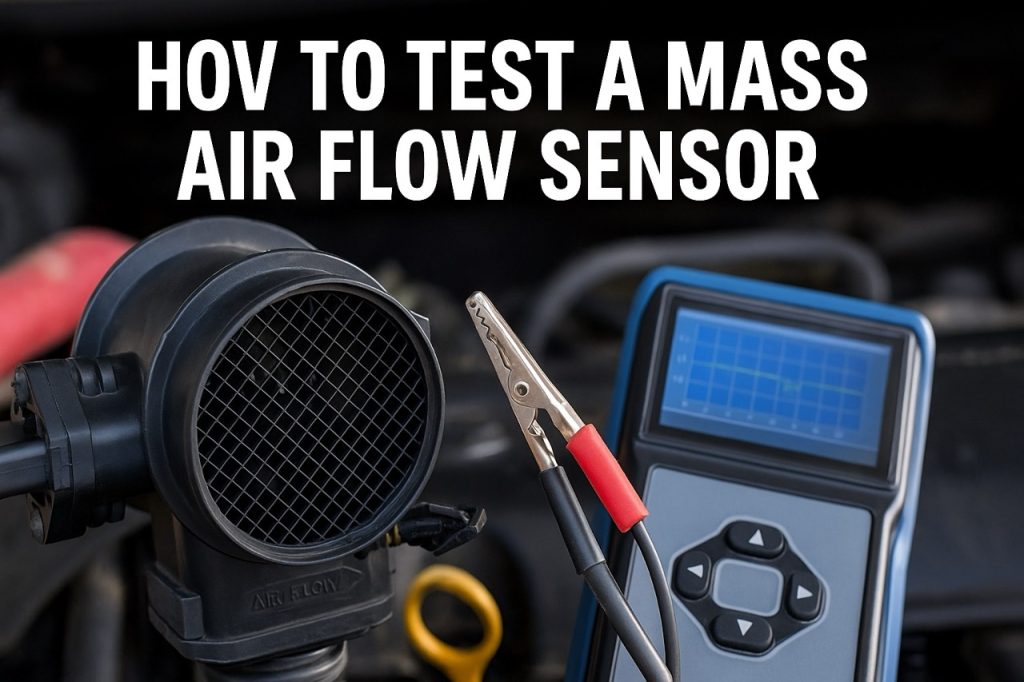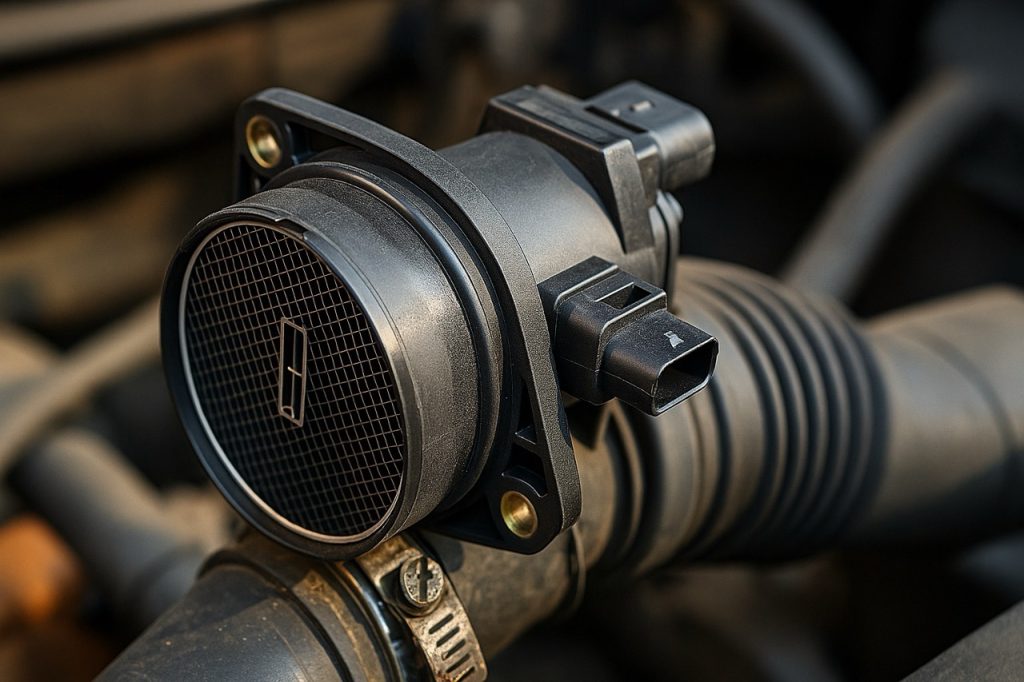In this article we look at how to test a mass air flow sensor without multimeter and how to test mass air flow sensor with multimeter, The mass air flow sensor (MAF sensor) is one of the most important components in your car’s engine management system. It measures the amount of air entering the intake so the ECU (engine control unit) can deliver the right amount of fuel. If the MAF sensor is dirty, failing, or providing incorrect readings, you’ll notice problems such as rough idle, poor fuel economy, hesitation, or even stalling.
But how do you know for sure? In this guide, we’ll explain how to test a mass air flow sensor, whether you have a multimeter, an OBD-II scanner, or no tools at all.

How to Check Mass Air Flow Sensor
If you’re asking how to check mass air flow sensor, the process usually involves inspecting, cleaning, and testing the sensor’s response. Start with these steps:
- Visual inspection: Remove the sensor and check for dirt, dust, or oil buildup. Sometimes, the issue is simply a dirty sensor.
- Check wiring and connectors: Loose or corroded connections can mimic a bad sensor.
- Scan for codes: Using an OBD-II scanner can reveal trouble codes related to airflow (like P0100, P0101, or P0102).
If no obvious issues are found, it’s time to move to more detailed testing. related: CRC Mass Air Flow Sensor Cleaner Review (Is It Worth It?)
How to Check MAF Sensor With a Multimeter
Many DIY mechanics want to know how to check MAF sensor electrically. With a digital multimeter, you can measure voltage and signal response.
- Set the multimeter to the correct voltage range (usually DC volts).
- Back-probe the signal wire at the sensor connector (consult your vehicle manual for wire colors).
- Start the engine and watch the voltage reading.
- At idle, the voltage should be stable (typically 0.5 to 1.5 volts).
- As you rev the engine, voltage should increase smoothly.
If the readings are erratic, flat, or don’t change, you may have a failing sensor. This is the standard way to test a mass air flow sensor with tools.
How to Tell If MAF Sensor Is Bad
Even without tools, there are common signs that answer the question: how to tell if MAF sensor is bad. These include:
- Rough idle or shaking when stopped.
- Poor acceleration or jerking when pressing the gas.
- Decreased fuel economy.
- Hard starts or stalling.
- A check engine light with airflow-related codes.
Sometimes, these can overlap with vacuum leaks or bad spark plugs. That’s why knowing how to test if MAF sensor is bad directly is important.

Can You Test a Mass Air Flow Sensor?
Yes, many people ask can you test a mass air flow sensor before replacing it. The answer is absolutely yes, and it’s strongly recommended. Too many MAF sensors are replaced unnecessarily when the real problem is a vacuum leak, dirty air filter, or faulty wiring.
Testing confirms whether the sensor is truly bad or if another issue is causing airflow-related symptoms.
How to Test If MAF Sensor Is Bad With an OBD-II Scanner
Another way to test is with live data from an OBD-II scanner:
- Plug in the scanner and look for airflow readings in grams per second (g/s).
- At idle, typical airflow for a 2.0-liter engine should be around 2–7 g/s. Larger engines will show higher numbers.
- Rev the engine and check if readings increase smoothly.
If values are far outside the normal range, this is how you check if MAF sensor is bad electronically. CRC Throttle Body Cleaner vs Mass Air Flow Sensor Cleaner: What’s the Difference?
How to Test a Bad Mass Air Flow Sensor Without Tools
You don’t always need expensive tools to diagnose. Here’s how to test a bad mass air flow sensor with just simple observation:
- Unplug the sensor while the engine is running. If the engine runs better with the sensor unplugged, your MAF sensor may be faulty.
- Tap test: Lightly tap the sensor with a screwdriver handle while the engine is idling. If the engine stumbles or dies, the sensor may have internal issues.
- Swap test (if possible): If you have access to another identical sensor (from the same model), try swapping it to see if symptoms disappear.
This is the easiest way to answer how to test a bad mass air flow sensor at home.
How to Test a Mass Air Flow Sensor Without Multimeter
Not everyone owns a multimeter. So, how to test a mass air flow sensor without multimeter?
- Use an OBD-II scanner: Even a basic Bluetooth scanner with a smartphone app can show live airflow readings.
- Unplug method: As mentioned earlier, disconnect the sensor. If engine behavior changes, the sensor is influencing performance (good or bad).
- Listen and feel: A faulty MAF sensor often causes surging, hesitation, or rough idle.
While this doesn’t replace accurate testing, it can give you a clear idea before spending money on parts.
Final Thoughts
Learning how to test a mass air flow sensor saves time, money, and frustration.
- How to check mass air flow sensor? Start with a visual inspection and wiring check.
- How to check MAF sensor with tools? Use a multimeter or OBD-II scanner for accurate voltage and airflow readings.
- How to tell if MAF sensor is bad? Look for symptoms like rough idle, poor fuel economy, and hesitation.
- Can you test a mass air flow sensor? Yes, and you should before replacing it.
- How to test a mass air flow sensor without multimeter? Use unplugging, scanner apps, or simple observation.
If your sensor shows signs of failure, try cleaning it first with a MAF sensor cleaner before replacing it. Many times, a simple cleaning restores performance and avoids unnecessary costs.
Always test before replacing. A $10 can of cleaner is cheaper than a $200 new sensor.
Related articles to read too:
- 15 Symptoms of a Bad Mass Air Flow Sensor (MAF) and How to Tell If It’s
- What Causes Mass Air Flow Sensor to Go Bad? Symptoms, Fixes, and How to Prevent It
- Best Ways of Cleaning Mass Air Flow Sensor for Better Fuel Economy
- How to Clean Mass Air Flow Sensor Step by Step (Beginner’s Guide)
- Best Mass Air Flow Sensor Cleaner Spray: CRC vs Alternatives
